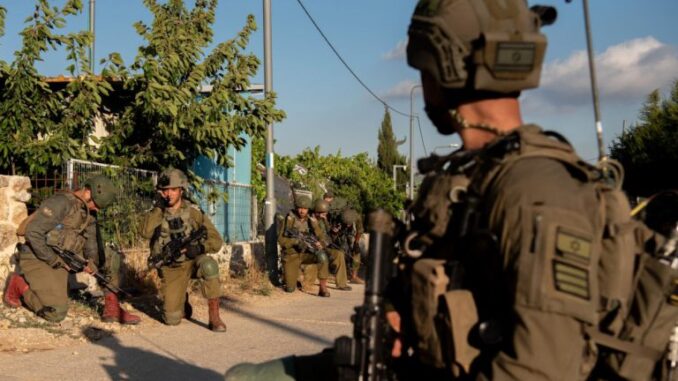T. Belman. When Glick interviewed Amiad Cohen, he acknowledged that Israel was killing the Hezbollah leadership and destroying military infastructure, both above and below ground south of the Litani R. This paves the way for the invasion.
BY SETH FRANTZMAN | July 3, 2024
Hezbollah launched rockets at northern Israeli communities hours after a senior Hezbollah commander was killed. An Israeli airstrike killed Muhammad Nimah Nasser in the city of Tyre on the coast of southern Lebanon on July 3.
Nasser was the commander of Hezbollah’s Aziz Unit, and his death comes two and a half weeks after another Israeli airstrike killed the commander of Hezbollah’s Nasr Unit, Taleb Sami Abdallah, on June 12. Hezbollah previously fired more than 215 rockets at Israel in response to the killing of Abdallah.
The pro-Iran media outlet Al-Mayadeen reported that Nasser was born in 1965 in Haddatha, a small village in the Bint Jbeil District in southern Lebanon that’s about five miles from the Israeli border. The report claimed he was killed in a drone strike that targeted a car he was in with other men. Another member of Hezbollah, Muhammad Ghassan Khashab, was also killed.
The IDF said that it “eliminated the terrorist Muhammad Nimah Nasser, the commander of the Hezbollah terrorist organization’s Aziz Unit which is responsible for firing from southwestern Lebanon at Israeli territory.” According to the IDF statement, Nasser took over the Aziz unit in 2016 and “led the firing of rockets and anti-tank missiles from southwestern Lebanon toward Israeli civilians, communities, and security forces. Furthermore, Nasser directed a large number of terror attacks toward Israel both during and before the war, and he previously held several central roles within the Hezbollah terrorist organization.”
The IDF noted that Nasser was a counterpart of Abdullah, “the commander of the Nasr Unit, who was eliminated last month. Together, they served as two of the most significant Hezbollah terrorists in southern Lebanon.”
Hezbollah carried out new attacks on Israel in the wake of the latest killing. Sirens sounded in the various areas, including the northern Israeli city of Kiryat Shmona. The city was evacuated in October, and only a few thousand of its 24,000 residents remain. Sirens also sounded in Metula and Manara, two Israeli communities on the Lebanon border. Later in the afternoon, more sirens sounded in Beit Hillel and Kfar Giladi in the Huleh Valley before sunset. In addition, there were sirens in Misgav Am, Margaliot, and Tel Hai, all areas near Kiryat Shmona.
The airstrike on Nasser follows two months of Hezbollah escalation and a desire by Israeli officials to end Hezbollah’s eight months of attacks on northern Israeli communities. Hezbollah has said it will not stop its attacks until there is a ceasefire in Gaza.
Iranian media have emphasized claims of Hezbollah’s success in these attacks. An article on July 3 in Iran’s Islamic Republic News Agency (IRNA) claimed that “fleeing Zionist settlers” have become refugees in Israeli hotels over the last eight months due to Hezbollah’s attacks. Around 50,000 Israelis remain evacuated from northern communities; many reside in hotels, and Iran and Hezbollah see this situation as a victory.
In other developments, Iran’s top diplomat, acting Foreign Minister Ali Bagheri Kani, warned on July 3 that if Israel increases attacks on Hezbollah, leading to a wider war, then Hezbollah will turn Lebanon into an “eternal hell” for any Israeli invasion.
Hezbollah’s response to the killing of Nasser followed attacks on July 2 when the group launched 15 rockets at northern Israel.
“Additionally, IDF troops identified a terrorist entering a Hezbollah military structure in the area of Yarine in southern Lebanon. Shortly following the identification, the IAF struck the military structure from which the terrorist operated,” the IDF said. Overnight between July 2 and July 3, the Israeli Air Force struck Hezbollah sites in southern Lebanon, including Blida, Yaroun, Aitaroun, Labbouneh, Chihine, and Tayr Harfa.
The IDF continues to prepare for a possible escalation in the north. Israel recently established the 810th Brigade, called the “Mountain Brigade,” which is designed to guard Mount Dov and Mount Hermon on the border with Lebanon. This new territorial brigade, stationed at a key border area between Israeli forces in the Galilee and the Golan Heights, is designed to ease the burden on the 91st Division, also deployed on the Lebanon border. The new brigade comes under the command of the 210th Division in the Golan.
The Mountain Brigade recently conducted a drill designed to increase its readiness for operations in the north. Various units deployed in northern Israel have conducted similar training as Israel prepares for a possible escalation with Hezbollah.




Leave a Reply
You must be logged in to post a comment.